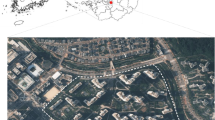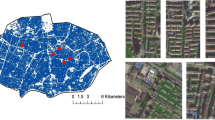Abstract
Planting trees around buildings has always been used as one of the most common viable landscaping strategies in schools. However, the impact of trees on natural ventilation inside the building has been neglected without investigation. The emphasis of this study related to the impact of outdoor trees around the academic building on indoor ventilation. Numerical simulations of the indoor wind environment of the academic building affected by trees were performed utilizing the k-ε model with additional source terms. The numerical model was also validated by measured data. Two kinds of trees were selected, they are camphor and metasequoia. Camphor is a kind of broad-leaved tree and metasequoia is a kind of coniferous tree. 26 simulation cases with six different tree canopy spacings were conducted. These results showed that the outdoor trees had great influences on the natural ventilation performance of the academic building. Compared with the case without the trees, the highest decrement in ventilation flow rate could be up to 31.97% in this study. For the cases of classrooms with horizontal distribution, the ages of air of the classrooms became fresher with the increase of the canopy spacing. While for the cases of classrooms with vertical distribution, the canopy spacing had fewer effects on the natural ventilation performances. It was also found that the blocking effects of camphor on indoor ventilation were higher than that of metasequoia. The average ventilation flow rate in cases with metasequoia was increased by 14.89% compared to the cases with camphor. This study could provide guidance for the layout design of trees around the building.
Similar content being viewed by others
Change history
01 April 2024
An Erratum to this paper has been published: https://doi.org/10.1007/s12273-024-1129-2
References
Almeida RMSF, Pinto M, Pinho PG, et al. (2017). Natural ventilation and indoor air quality in educational buildings: experimental assessment and improvement strategies. Energy Efficiency, 10: 839–854.
Architectural Institute of Japan (2007). Guidebook for CFD Predictions of Urban Wind Environment. Available at https://www.aij.or.jp/aijhome.htm. Accessed 21 Jan 2022.
Blocken B, Stathopoulos T, Carmeliet J (2007). CFD simulation of the atmospheric boundary layer: Wall function problems. Atmospheric Environment, 41: 238–252.
Dong Y, Zhu L, Li S, et al. (2022). Optimal design of building openings to reduce the risk of indoor respiratory epidemic infections. Building Simulation, 15: 871–884.
Dovjak M, Slobodnik J, Krainer A (2020). Consequences of energy renovation on indoor air quality in kindergartens. Building Simulation, 13: 691–708.
Gan VJL, Wang B, Chan CM, et al. (2022). Physics-based, data-driven approach for predicting natural ventilation of residential high-rise buildings. Building Simulation, 15: 129–148.
Ghaddar D, Itani M, Ghaddar N, et al. (2021). Model-based adaptive controller for personalized ventilation and thermal comfort in naturally ventilated spaces. Building Simulation, 14: 1757–1771.
Durbin PA (1995). Separated flow computations with the k-epsilon-v-squared model. AIAA Journal, 33: 659–664.
Green S (1992). Modeling turbulent air flow in a stand of widely spaced trees. PHOENICS Journal, 5: 294–312.
Gromke C, Ruck B (2007). Influence of trees on the dispersion of pollutants in an urban street canyon—Experimental investigation of the flow and concentration field. Atmospheric Environment, 41: 3287–3302.
Gromke C, Ruck B (2008). Aerodynamic modelling of trees for small-scale wind tunnel studies. Forestry, 81: 243–258.
Guo X, Gao Z, Buccolieri R, et al. (2021). Effect of greening on pollutant dispersion and ventilation at urban street intersections. Building and Environment, 203: 108075.
Haverinen-Shaughnessy U, Moschandreas DJ, Shaughnessy RJ (2011). Association between substandard classroom ventilation rates and students’ academic achievement. Indoor Air, 21: 121–131.
Hong B, Lin B, Qin H (2017). Numerical investigation on the coupled effects of building-tree arrangements on fine particulate matter (PM2.5) dispersion in housing blocks. Sustainable Cities and Society, 34: 358–370.
Hong B, Qin H, Jiang R, et al. (2018). How outdoor trees affect indoor particulate matter dispersion: CFD simulations in a naturally ventilated auditorium. International Journal of Environmental Research and Public Health, 15: 2862.
Kang G, Kim JJ, Kim DJ, et al. (2017). Development of a computational fluid dynamics model with tree drag parameterizations: Application to pedestrian wind comfort in an urban area. Building and Environment, 124: 209–218.
Kenjereš S, ter Kuile B (2013). Modelling and simulations of turbulent flows in urban areas with vegetation. Journal of Wind Engineering and Industrial Aerodynamics, 123: 43–55.
Kurotani Y, Kiyota N, Kobayashi S (2001). Windbreak effect of Tsuijimatsu in Izumo Part. 2. In: Proceedings of Summaries of Technical Papers of Annual Meeting Architectural Institute of Japan. (in Japanese)
Li C, Yoo SJ, Ito K (2023). Impact of indoor ventilation efficiency on acetone inhalation exposure concentration and tissue dose in respiratory tract. Building Simulation, 16: 427–441.
Liang W, Qin M (2017). A simulation study of ventilation and indoor gaseous pollutant transport under different window/door opening behaviors. Building Simulation, 10: 395–405.
Liu T, Lee WL (2020). Influence of window opening degree on natural ventilation performance of residential buildings in Hong Kong. Science and Technology for the Built Environment, 26: 28–41.
Liu X, Yang L, Niu S (2021). Research on the effect of different position on classroom ventilation in a “L” type teaching building. Journal of Building Engineering, 33: 101852.
Mendell MJ, Heath GA (2005). Do indoor pollutants and thermal conditions in schools influence student performance? A critical review of the literature. Indoor Air, 15: 27–52.
Mochida A, Tabata Y, Iwata T, et al. (2008). Examining tree canopy models for CFD prediction of wind environment at pedestrian level. Journal of Wind Engineering and Industrial Aerodynamics, 96: 1667–1677.
Morshed T (2014). An investigation of naturally ventilated teaching spaces with windcathers in secondary school where site is constrained by noise and air pollution. Building Simulation, 7: 547–561.
Rabeharivelo R, Kavraz M, Aygün C (2022). Thermal comfort in classrooms considering a traditional wind tower in Trabzon through simulation. Building Simulation, 15: 401–418.
Rui L, Buccolieri R, Gao Z, et al. (2019). Study of the effect of green quantity and structure on thermal comfort and air quality in an urban-like residential district by ENVI-met modelling. Building Simulation, 12: 183–194.
Salmond JA, Williams DE, Laing G, et al. (2013). The influence of vegetation on the horizontal and vertical distribution of pollutants in a street canyon. Science of the Total Environment, 443: 287–298.
Sandberg M (1981). What is ventilation efficiency? Building and Environment, 16: 123–135.
Shendell DG, Prill R, Fisk WJ, et al. (2004). Associations between classroom CO2 concentrations and student attendance in Washington and Idaho. Indoor Air, 14: 333–341.
Song D, Zhang X, Zhou X, et al. (2022). Influences of wind direction on the cooling effects of mountain vegetation in urban area. Building and Environment, 209: 108663.
Subhashini S, Thirumaran K (2020). CFD simulations for examining natural ventilation in the learning spaces of an educational building with courtyards in Madurai. Building Services Engineering Research and Technology, 41: 466–479.
Tham KW (2016). Indoor air quality and its effects on humans—A review of challenges and developments in the last 30 years. Energy and Buildings, 130: 637–650.
Tominaga Y, Mochida A, Yoshie R, et al. (2008). AIJ guidelines for practical applications of CFD to pedestrian wind environment around buildings. Journal of Wind Engineering and Industrial Aerodynamics, 96: 1749–1761.
von Grabe J, Svoboda P, Bäumler A (2014). Window ventilation efficiency in the case of buoyancy ventilation. Energy and Buildings, 72: 203–211.
Wolkoff P (2018). Indoor air humidity, air quality, and health — An overview. International Journal of Hygiene and Environmental Health, 221: 376–390.
Xue F, Li X (2017). The impact of roadside trees on traffic released PM10 in urban street canyon: Aerodynamic and deposition effects. Sustainable Cities and Society, 30: 195–204.
Zhang X, Chen L, Jiang W, et al. (2022). Urban heat island of Yangtze River Delta urban agglomeration in China: Multi-time scale characteristics and influencing factors. Urban Climate, 43: 101180.
Zhou X, Lu Y, Hu S, et al. (2023). New perspectives on temporal changes in occupancy characteristics of residential buildings. Journal of Building Engineering, 64: 105590.
Acknowledgements
This research was supported by Ministry of Science and Technology of China (No. 2020YFC1522304), the Natural Science Foundation of China (No. 52078118), and the Opening Fund of State Key Laboratory of Green Building in Western China (No. LSKF202107).
Author information
Authors and Affiliations
Contributions
All authors contributed to the study conception and design. Material preparation, data collection and analysis were performed by Shengnan Niu, Xiaodong Liu, Annan Wang, and Lufang Chen. The first draft of the manuscript was written by Shengnan Niu and Xing Jin. Review, editing and supervision were performed by Shengnan Niu, Xin Zhou, Xing Shi, Liu Yang, and Xing Jin. All authors commented on previous versions of the manuscript. All authors read and approved the final manuscript.
Corresponding author
Additional information
Declaration of competing interest
The authors have no competing interests to declare that are relevant to the content of this article.
Rights and permissions
About this article
Cite this article
Niu, S., Liu, X., Wang, A. et al. Research on the influence of outdoor trees on natural ventilation performance of an academic building. Build. Simul. 16, 927–946 (2023). https://doi.org/10.1007/s12273-022-0977-x
Received:
Revised:
Accepted:
Published:
Issue Date:
DOI: https://doi.org/10.1007/s12273-022-0977-x




